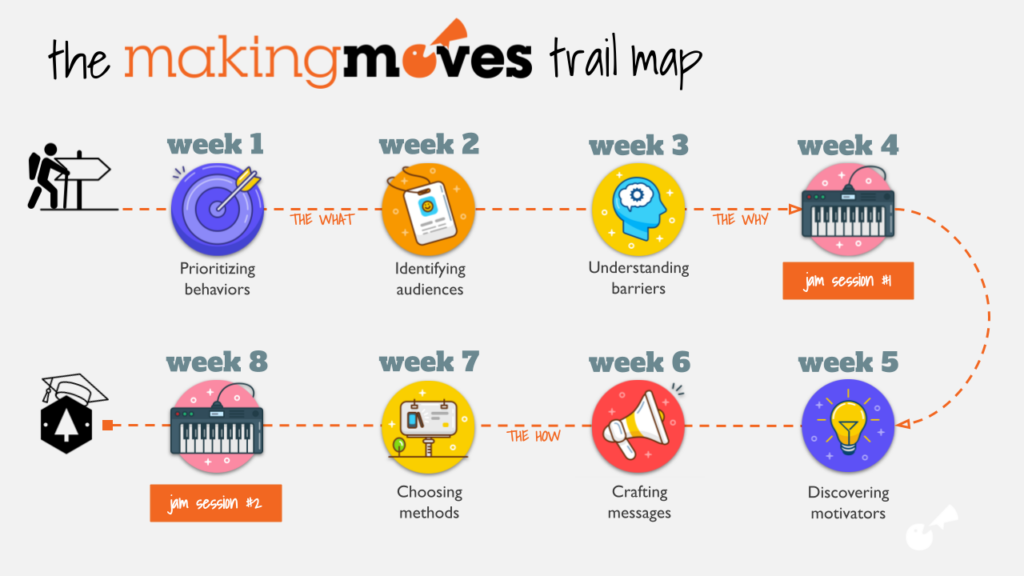
Thank you for your interest in the Making Moves course!
The trailmap outlines weekly lessons and activities we cover during the course. Click each of the headers below to see specific learning objectives for each session.
Enjoy!
-brooke
Week 1: Prioritizing Behaviors
 To motivate action and change among our busy audience members, it is critical to be extremely clear on what we’re asking people to do so the audience knows what direction they should head in.
To motivate action and change among our busy audience members, it is critical to be extremely clear on what we’re asking people to do so the audience knows what direction they should head in.
Lesson #1 helps you create a clearer picture of what you’re asking audiences to do.
This includes:
1. Identifying the specific behavior you want your audience to adopt.
2. Outlining the detailed steps related to doing the desired behavior.
3. Mapping the journey from current behaviors to the desired behavior.
By the end of this lesson, you’ll have a clear path of steps the audience should take that moves them from current behaviors towards the desired behavior.
Week 2: Identifying Audiences
 Gaining insight about our priority audience, combined with insight on human behavioral truths (coming up next!), equips us to make smart, informed decisions on how to best motivate action and change.
Gaining insight about our priority audience, combined with insight on human behavioral truths (coming up next!), equips us to make smart, informed decisions on how to best motivate action and change.
Lesson #2 helps you select a priority target audience and develop a better understanding of who they are.
This includes:
1. Narrowing the size and scale of the audience.
2. Defining audience segments and selecting a priority audience.
3. Identifying the challenges your audience faces with adopting the desired behavior.
4. Exploring the spheres of influence around your audience and how they may need to be engaged.
By the end of this lesson, you’ll have a clear picture of who you will be speaking to in your communication and outreach plan.
Week 3: Understanding Barriers
 The force field analysis helps develop an informed, audience-centric strategy to achieve the primary behavior change goal by increasing internal and external motivators and decreasing internal & external deterrents.
The force field analysis helps develop an informed, audience-centric strategy to achieve the primary behavior change goal by increasing internal and external motivators and decreasing internal & external deterrents.
Lesson #3 focuses on the category of deterrents to identify what’s preventing your audience from taking action and changing behaviors.
This includes:
1. Identifying which internal and external deterrents may impact your audience.
2. Exploring strategies for avoiding, removing, reducing, and solving deterrents.
3. Mapping the occurrence of deterrents in the behavior journey.
By the end of this lesson, you will have an initial plan for overcoming the main external and internal deterrents preventing the audience from moving forward.
Week 4: Jam Session #1
 Jam sessions are where we practice using the concepts covered so far before we move into the second half of instructional lessons. Think of it as a group working session.
Jam sessions are where we practice using the concepts covered so far before we move into the second half of instructional lessons. Think of it as a group working session.
Jam sessions are an opportunity to:
- Actively apply techniques towards another case example: reducing food waste.
- Meet other cohort members.
- Ask questions and discuss challenges.
- Take a break from instructional lessons to let concepts sink-in.
Week 5: Discovering Motivators
 Now we move on to identifying which motivators we can leverage to jump-start action among our audiences and sustain their momentum towards change.
Now we move on to identifying which motivators we can leverage to jump-start action among our audiences and sustain their momentum towards change.
Lesson #4 dives into the left side of the force field analysis to explore what motivates people to take action and change their behaviors.
This includes:
1. Defining each of the 10 motivators, including why and how they work to motivate people.
2. Exploring ideas for creating, increasing, and promoting motivators.
3. Mapping when motivators may be needed most in the behavior journey to overcome deterrents and start or grow the movement.
By the end of this lesson, you will have identified a set of external and internal forces that will motivate your audience throughout the behavior journey.
Week 6: Crafting Messages
 Effective messages are created through an empathetic understanding of who our audience is and what prevents them from taking action, combined with our strategic approach to identifying motivators and reasons why they WILL get up and do something.
Effective messages are created through an empathetic understanding of who our audience is and what prevents them from taking action, combined with our strategic approach to identifying motivators and reasons why they WILL get up and do something.
The goal of this lesson is to explore options for how we will communicate the desired behavior to the intended audience using words and images to convey the message.
This includes:
1. Creating clear calls-to-action for the desired behavior and important steps in the journey.
2. Selecting message frames based on motivators previously identified.
3. Writing the message using different message frames.
4. Selecting images that best support the message.
By the end of this lesson, you will be able to turn desired behaviors into messages that motivate action and change!
Week 7: Choosing Methods
 Having a great, motivating message does not do us any good if the intended audience never sees it!
Having a great, motivating message does not do us any good if the intended audience never sees it!
The goal of this lesson is to identify all the moments when it’s possible to deliver a message to the intended audience and determine the ideal mix of outreach and communication options for those moments.
This includes:
1. Identifying moments in the behavior journey when you can reach the audience.
2. Creating wider buzz and repetition around the message by expanding beyond the target audience.
3. Exploring available options for communication and outreach methods to include in the project.
By the end of this lesson, you will have identified a set of communication and outreach activities that will get your messages in front of your audience.
Week 8: Jam Session #2
 In our last session together, we’ll practice our new skills and close out the course with a celebration.
In our last session together, we’ll practice our new skills and close out the course with a celebration.
This includes:
1. Practice activities: We dive back into the ‘food waste’ topic from the first jam session and move our initial ideas forward. Together, we’ll create messages using different frames, select methods for reaching our audience, and critique a few more real-world ads.
2. Celebration: We’ll look back at what we’ve learned and shared, celebrate the journey we’ve taken together, and look ahead to the alumni network.
Head back to the course page
There’s a lot more to Making Moves than weekly lessons and jam sessions. Head back to the course page to see all the features and benefits of joining the course. Reach out with any questions you have!


